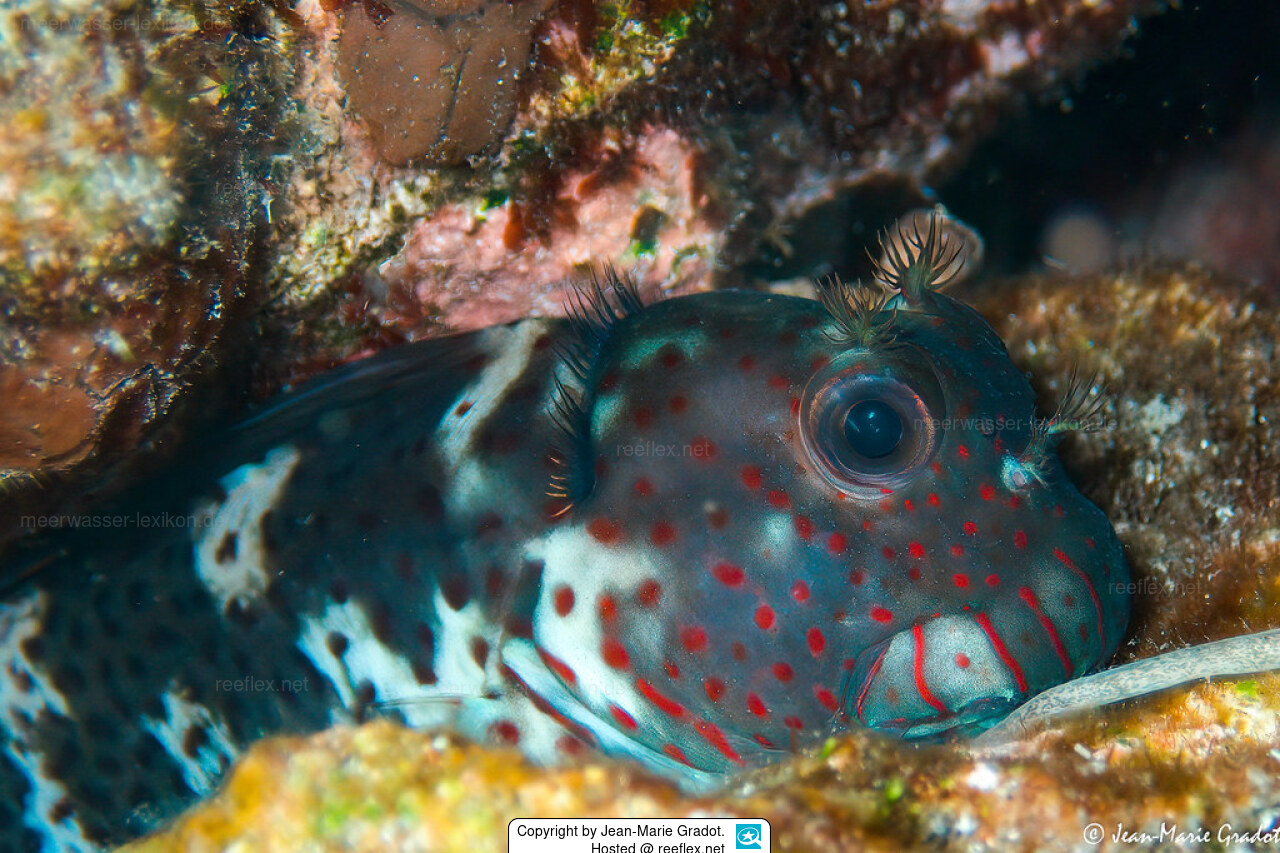Info
(Forster & Schneider, 1801)
Distribution:
Indo-Pacific: Red Sea and East Africa to the Line, Marquesan, and Tuamoto islands, north to southern Japan, south to Lord Howe and Rapa.
Intertidal. Common in areas with large rubble pieces which are often used to built breakwaters or to support jetty-pylons. Hides in cracks or holes when not feeding.
Adults jump out of the water in energetic skippings to another pool when pursued.
May remain out of water under rocks or seaweeds . They breathe air when out of water.
Oviparous, eggs are demersal and adhesive.
Synonymised taxa:
Alticops edentulus (Forster & Schneider, 1801)
Blennius cinereus Castelnau, 1875
Blennius edentulus Forster & Schneider, 1801
Blennius truncatus Forster, 1801
Istiblennius edentululus (Forster & Schneider, 1801) (misspelling)
Istiblennius enosimae (Jordan & Snyder, 1902)
Istilbennius edentulus (Forster & Schneider, 1801) (misspelling)
Salarias atratus Macleay, 1882
Salarias atrimarginatus Fowler, 1946
Salarias azureus Seale, 1906
Salarias diproktopterus Bleeker, 1857
Salarias fluctatus Fowler, 1945
Salarias garmani Jordan & Seale, 1906
Salarias gilberti Bryan & Herre, 1903
Salarias insulae Ogilby, 1899
Salarias marcusi Bryan & Herre, 1903
Salarias melanocephalus Bleeker, 1849
Salarias quadricornis Valenciennes, 1836
Salarias rechingeri Steindachner, 1906
Salarias sindonis Jordan & Seale, 1906
Salarias sumatranus Bleeker, 1851
Scartella enosimae (Jordan & Snyder, 1902)
Scartichthys basiliscus Fowler, 1904
Scartichthys enosimae Jordan & Snyder, 1902
Classification: Biota > Animalia (Kingdom) > Chordata (Phylum) > Vertebrata (Subphylum) > Gnathostomata (Superclass) > Pisces (Superclass) > Actinopteri (Class) > Perciformes (Order) > Blennioidei (Suborder) > Blenniidae (Family) > Salariinae (Subfamily) > Istiblennius (Genus) > Istiblennius edentulus (Species)
Jumping guard
A jumping guard prevents (nocturnal) fish from jumping out.
Wrasses, blennies, hawkfishs and gobies jump out of an unprotected tank in fright if their night rest is disturbed, unfortunately these jumpers are found dried up in the morning on carpets, glass edges or later behind the tank.
https://www.korallenriff.de/en/article/1925_5_Jump_Protection_Solutions_for_Fish_in_the_Aquarium__5_Net_Covers.html
A small night light also helps, as it provides the fish with a means of orientation in the dark!
Distribution:
Indo-Pacific: Red Sea and East Africa to the Line, Marquesan, and Tuamoto islands, north to southern Japan, south to Lord Howe and Rapa.
Intertidal. Common in areas with large rubble pieces which are often used to built breakwaters or to support jetty-pylons. Hides in cracks or holes when not feeding.
Adults jump out of the water in energetic skippings to another pool when pursued.
May remain out of water under rocks or seaweeds . They breathe air when out of water.
Oviparous, eggs are demersal and adhesive.
Synonymised taxa:
Alticops edentulus (Forster & Schneider, 1801)
Blennius cinereus Castelnau, 1875
Blennius edentulus Forster & Schneider, 1801
Blennius truncatus Forster, 1801
Istiblennius edentululus (Forster & Schneider, 1801) (misspelling)
Istiblennius enosimae (Jordan & Snyder, 1902)
Istilbennius edentulus (Forster & Schneider, 1801) (misspelling)
Salarias atratus Macleay, 1882
Salarias atrimarginatus Fowler, 1946
Salarias azureus Seale, 1906
Salarias diproktopterus Bleeker, 1857
Salarias fluctatus Fowler, 1945
Salarias garmani Jordan & Seale, 1906
Salarias gilberti Bryan & Herre, 1903
Salarias insulae Ogilby, 1899
Salarias marcusi Bryan & Herre, 1903
Salarias melanocephalus Bleeker, 1849
Salarias quadricornis Valenciennes, 1836
Salarias rechingeri Steindachner, 1906
Salarias sindonis Jordan & Seale, 1906
Salarias sumatranus Bleeker, 1851
Scartella enosimae (Jordan & Snyder, 1902)
Scartichthys basiliscus Fowler, 1904
Scartichthys enosimae Jordan & Snyder, 1902
Classification: Biota > Animalia (Kingdom) > Chordata (Phylum) > Vertebrata (Subphylum) > Gnathostomata (Superclass) > Pisces (Superclass) > Actinopteri (Class) > Perciformes (Order) > Blennioidei (Suborder) > Blenniidae (Family) > Salariinae (Subfamily) > Istiblennius (Genus) > Istiblennius edentulus (Species)
Jumping guard
A jumping guard prevents (nocturnal) fish from jumping out.
Wrasses, blennies, hawkfishs and gobies jump out of an unprotected tank in fright if their night rest is disturbed, unfortunately these jumpers are found dried up in the morning on carpets, glass edges or later behind the tank.
https://www.korallenriff.de/en/article/1925_5_Jump_Protection_Solutions_for_Fish_in_the_Aquarium__5_Net_Covers.html
A small night light also helps, as it provides the fish with a means of orientation in the dark!







 Jean-Marie Gradot, La Reunion
Jean-Marie Gradot, La Reunion













